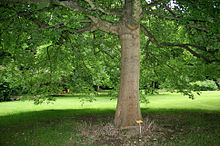Oregon ash
| Oregon ash | |
|---|---|
 |
|
| A mature tree at the National Botanic Garden of Belgium | |
| Scientific classification | |
| Kingdom: | Plantae |
| (unranked): | Angiosperms |
| (unranked): | Eudicots |
| (unranked): | Asterids |
| Order: | Lamiales |
| Family: | Oleaceae |
| Genus: | Fraxinus |
| Species: | F. latifolia |
| Binomial name | |
|
Fraxinus latifolia Benth. |
|
 |
|
| Native range | |
Fraxinus latifolia (Oregon ash) is a member of the ash genus Fraxinus, native to western North America.
Fraxinus latifolia is found on the west side of the Cascade Range from southwestern British Columbia south through western Washington, western Oregon, and northwestern California; and in central California in the Sierra Nevada.
Fraxinus latifolia can grow to 25 m (80 ft) in height, with a trunk diameter of 30–80 cm (12–31 in). The compound leaves are pinnate, 12–33 cm (4 3⁄4–13 in) long, with 5-9 leaflets, each leaflet ovate, 6–12 cm (2 1⁄4–4 3⁄4 in) long and 3–4 cm (1 1⁄8–1 5⁄8 in) broad, and often show signs of disease and brown rot, even on otherwise healthy plants. It is dioecious. The fruit is a samara, 3–5 cm (1 1⁄8–2 in) long including the wing.
The Oregon ash prefers damp, loose soils, and grows from sea level to 900 metres (3,000 ft) in elevation, up to 1,700 metres (5,600 ft) in the south of the range in California. In central Southern California, it intergrades with Fraxinus velutina (velvet ash) of southern California east into Arizona.
...
Wikipedia
